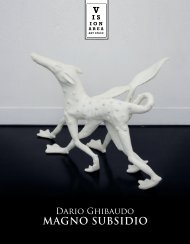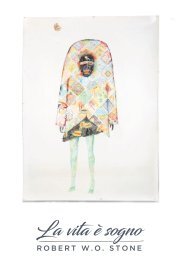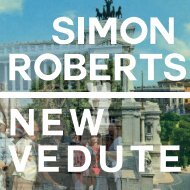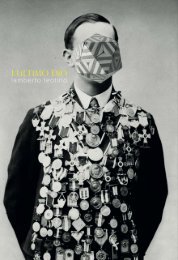WEB_catalogo very regina
Create successful ePaper yourself
Turn your PDF publications into a flip-book with our unique Google optimized e-Paper software.
capital, has resumed the tradition of dressing up and working on the body and on identity, and<br />
on multiple identities, with great precision, a highly iconic language and a completely original<br />
strength and sensitivity.<br />
Vittoria Regina is in fact working on herself and her own body as an open, virgin space, on which<br />
to experiment from time to time with unforeseen and unexpected visions, extracted by surprise<br />
from the contraints of e<strong>very</strong>day life, through the creation, as meticulous as it is professionally<br />
impeccable, of strange puzzle-images that are difficult to interpret, as if you are sitting in front<br />
of mysterious visual and brain teasers, subtly, or sometimes openly, disturbing, where the formal<br />
rigidity in which they are placed and the imperturbability of the expressions embodied in her<br />
protagonist seem actually to hide the traces of subtle and obscure existential wounds that seem to<br />
open breaches towards a different interpretation of the same forms of reality. The character of<br />
these works is, as in the paintings of the great surrealist masters, that of certain dreams of which<br />
we happen sometimes to remember not the entire sequence, but only an image, a snapshot or just<br />
a feeling, incongruous and surprising as they always appear and, on waking, the incongruous and<br />
surprising images and feelings that remind us of the dreams, of which we can maybe not really<br />
decipher the hidden meaning - if we can really talk a single meaning - while realising that they<br />
possess, in their crystalline ineffability, something that concerns us deeply, that tells something<br />
about us that we have repressed or that we have never been able to express or analyse at a<br />
conscious level, and yet that we recognise as our own, as belonging to our most intimate existential<br />
and deepest core, more logical and rational than any description or reflection. They are images<br />
(or visions) that seem to refer to the dreamlike activity according to the key that Breton himself<br />
ascribed to the waking/dream relationship since his First Manifesto of Surrealism when he spoke<br />
of waking as a mere “phenomenon of interference” compared with the time of the dream, which<br />
refers to it constantly as the real key of their unconscious behavior, and their lapses and emotions<br />
during waking. It is the eternal story of the uncertain and vague performance of our reasoning<br />
and rational side, and its systematic and periodic loss, destruction and disappearance, even in its<br />
“normal operation” day to day, therefore during the long oblivion of any “normal” day (at work,<br />
in relationships, in e<strong>very</strong>day life, with family or friends), with feelings, fears, anxieties, emotions<br />
and psychological effects which have little or nothing to do with rationality, and which on the<br />
other hand seem to run away - whether we like or not to recognise it - to that place that is the most<br />
intimate and the most mysterious aspect of our existential core, what psychoanalysis has wanted<br />
to rebaptise with the name of the unconscious, and that, by similarity, seems in turn to reconnect<br />
us directly with the most irrational part of us, that also seems to be the most familiar - dreaming,<br />
that is. “As well as it is done,” wrote Breton about the state of wakefulness, “its balance is relative;<br />
it hardly dares express itself, and, if it does, it limits itself to stating that an idea or a woman has<br />
an effect on it. What effect, it would be unable to say; in this way, it gives the measure of its own<br />
subjectivity, and nothing else. Despairing of a cause, it then invokes the case of the darker god of<br />
the other, to which it attributes its own bewilderment.” But, continues the inventor of surrealism,<br />
“Who will tell me that the angle under which the idea that moves him appears, that what he likes<br />
in the eye of the woman is not precisely what links him to dreaming and chains him to the data<br />
that through his own fault he has lost? “
















